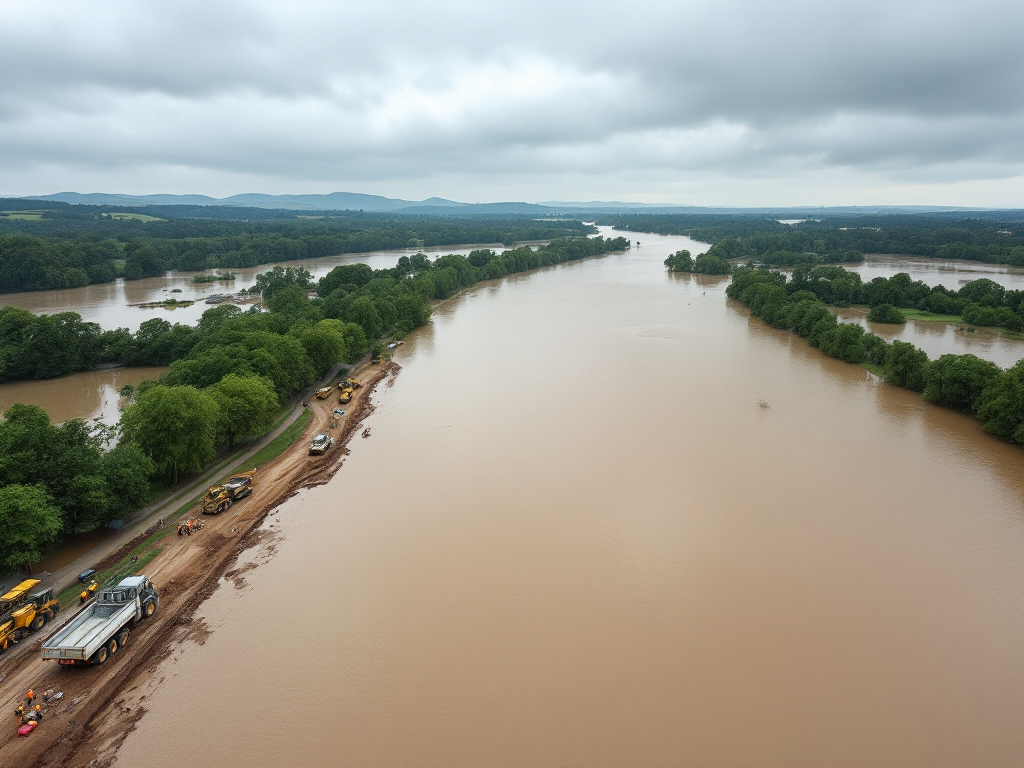Emerging Flood Threats Prompt Precautionary Measures
Heavy rains and rising river levels are causing increasing concern across several U.S. states, notably Tennessee, Ohio, and Arkansas, leading to precautions by local authorities and the U.S. Army Corps of Engineers. Particularly affected are communities around the Cumberland and Ohio Rivers, where flooding threats prompted immediate response actions such as water management adjustments and floodgate installations.
In Tennessee, substantial rainfall over the past few days has significantly elevated water levels along the Cumberland River, especially downstream of Nashville, near Clarksville. The National Weather Service has forecasted additional rainfall, exacerbating flooding risks as water systems remain saturated from previous storms.
David Bogema, Water Management Section Chief for the U.S. Army Corps of Engineers, underscored the high stakes involved, stating, “Public safety, of course, is our number one priority.” This commitment has translated into precise operational management of dam infrastructure along the Cumberland River, particularly at Percy Priest Dam, Center Hill Dam, Dale Hollow Dam, and Wolf Creek Dam. However, the Old Hickory Dam, limited by structural constraints, cannot hold back significant water volumes, necessitating the release of substantial flows downstream, raising alarm about possible flooding.
“With the ground already saturated, any additional rainfall is quickly turning runoff into river flow, significantly heightening flood risks,” explained Bogema in a recent address regarding Cumberland River management strategies.
As rivers swell, local authorities continue to actively monitor water levels and prepare for potential evacuations, road closures, and property damage.
Flood Gates and Infrastructure Responses to Rising Rivers
In Cincinnati, the rising levels of the Ohio River have warranted decisive action. The Greater Cincinnati Water Works installed flood gates at critical points, including the western end of Mehring Way and earlier at Carr Street. These measures are part of a larger strategy designed not only to protect infrastructure but also to ensure public safety amid increased flooding threats.
Installation of these flood gates has temporarily disrupted local traffic, forcing city officials to implement detours and road closures. Drivers in the area have been advised to exercise caution, reduce speeds, and follow detour signs closely.
“These necessary infrastructure adjustments underscore the logistical challenges city management faces when dealing with natural disasters,” noted city planning officials in Cincinnati following the recent flood gate installations.
Meanwhile, Northeast Ohio remains under a Flood Watch extending through Sunday morning. Major cities, including Cleveland, Akron, Elyria, and Medina, are particularly vulnerable following persistent rains. The National Weather Service has warned residents to remain vigilant, particularly in urban and low-lying areas prone to rapid water accumulation and flash flooding. Saturated grounds from prior rainfall further heighten the region’s vulnerability, stressing emergency services engaged in preventive preparations and public safety advisories.
Stormwater Runoff Challenges Intensify with Urbanization
In Northwest Arkansas, burgeoning urbanization is compounding the flood risk by reducing green spaces necessary for natural stormwater absorption. Local development authorities have highlighted concerns regarding the ecological consequences of intensified stormwater runoff, including habitat degradation and increased pollutant levels in local waterways.
Rapid city expansion with new businesses, residences, parking lots, and other impervious surfaces exacerbates these problems, as it limits the natural absorption capacity of stormwater. This has resulted in increased runoff velocities, which threaten both ecological integrity and public safety by accelerating stream bank erosion and flooding potential.
Chris Brown, Fayetteville’s Public Works Director, suggests adjusting stormwater fees based on the extent of impervious surfaces on properties, highlighting a direct link between urban development and the ecological footprint.
“We must rethink urban planning, ensuring it integrates sustainable stormwater management strategies,” Brown emphasized in a recent city council meeting.
Projections indicate Northwest Arkansas could reach a population of one million by 2050, further intensifying these challenges. Local planners and environmental groups are actively advocating for policies and infrastructure that mitigate these impacts, including enhanced drainage facilities and green infrastructure investments.
Across these regions, authorities continue to stress the importance of public awareness and preparedness as ongoing and future rainfall events pose serious risks to communities. Preventive measures and strategic infrastructure improvements represent critical components of the broader regional response to increasing flood threats.


